Once you understand how easy and common it is for thieves to attach “skimming” devices to ATMs and other machines that accept debit and credit cards, it’s difficult not to closely inspect and even tug on the machines before using them. Several readers who are in the habit of doing just that recently shared images of skimmers they discovered after gently pulling on various parts of a cash machine they were about to use.
Viewed from less than two feet away, this ATM looks reasonably safe to use, right?
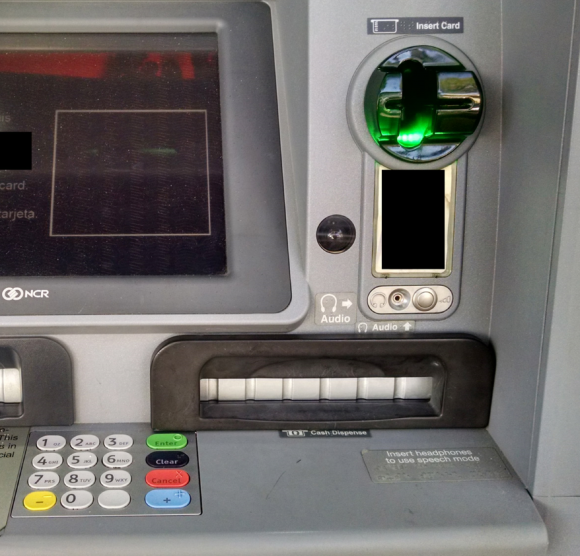
Although it may be difficult to tell from even this close, this ATM’s card acceptance slot and cash dispenser are both compromised by skimming devices.
But something fishy comes into view when we change our perspective slightly. Can you spot what doesn’t belong here?
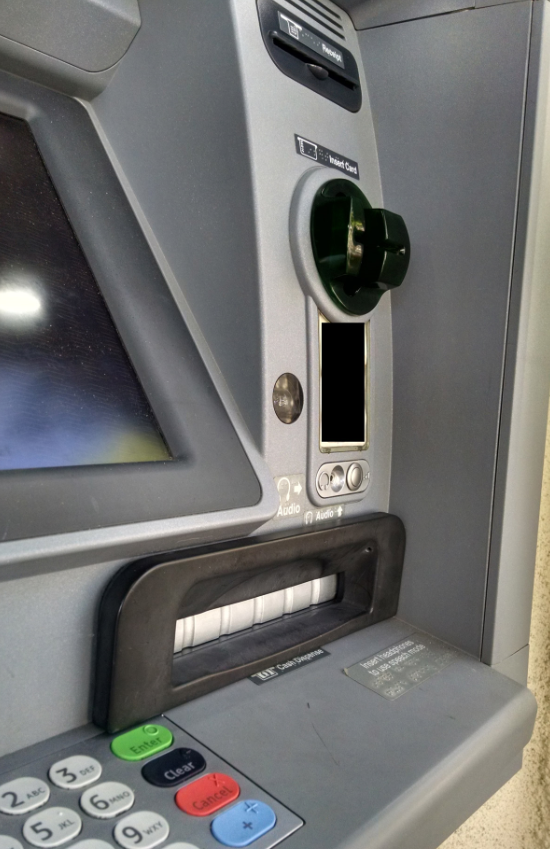
Can you spot what doesn’t belong here?
Congratulations if you noticed the tiny pinhole in the upper right corner of the phony black bezel that was affixed over top of the cash dispenser slot. That fake bezel overlay contained a tiny pinhole camera angled toward the PIN pad to record time-stamped videos of people entering their PINs:

A closeup of the tiny pinhole that allows a mini spy camera embedded in the fake cash dispenser bezel to record customers entering their PINs.
How about the card acceptance slot? Looks legit (if a tad shinier than the rest of the ATM), right?
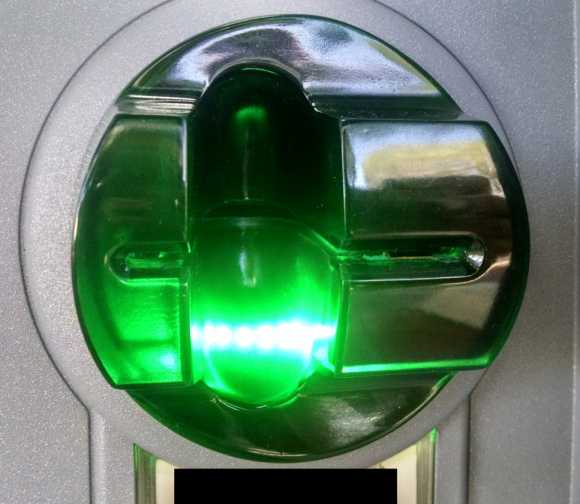
What happens if we apply a tiny bit of pressure to the anti-skimming green bezel where customers are expected to insert their ATM cards? Look at that! The cheap plastic bezel that skimmer thieves placed on top of the real card acceptance slot starts to pull away. Also, you can see some homemade electronics that are not very well hidden at the mouth of the bezel.
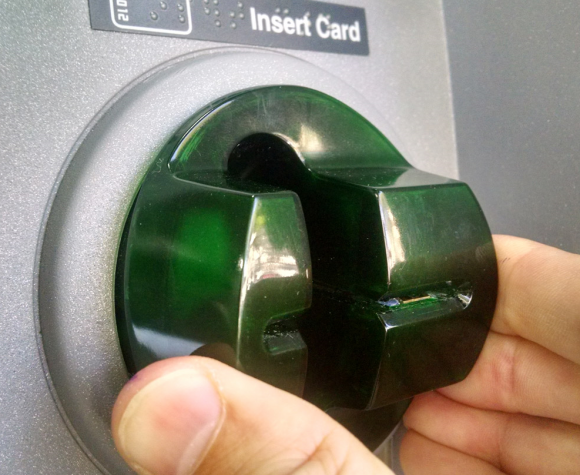
Notice the left side of this card skimmer overlay starts to pull away from the rest of the facade when squeezed. Also note the presence of a circuit board close to the mouth of the fake bezel.
ATM card skimmers contain tiny bits of electronics that record payment card data from the magnetic stripe on the backs of cards inserted into a hacked ATM. Most commonly (as in this case), a card skimmer is paired with a pinhole spy camera hidden above or beside the PIN pad to record time-stamped video of cardholders entering their PINs. Taken together, the stolen data allows thieves to fabricate new cards and use PINs to withdraw cash from victim accounts.
Card skimmers designed to look like the green anti-skimming devices found on many ATMs are some of the most common cash machine skimming devices in use today, probably because they are relatively cheap to manufacture en masse and there are many fraudsters peddling these in the cybercrime underground.
Typically, the fake anti-skimmer bezels like the one pictured above are made of hard plastic. However, the reader who shared these images said this bezel card skimming device was made of a semi-flexible, vinyl-like plastic material.
“I immediately went in and notified the manager who shut down the machine,” the reader said in an email to KrebsOnSecurity. “All the tellers were busy so he asked me to stand by the ATM and stop people from trying to use it while he called his security team. In the three minutes I was standing there a young woman came up and started to dip her card in the slot even thought the screen was black. I stopped her and told her and pointed out what was going. She was thankful.”
Normally, these bezel skimmers look more like the hard plastic one that came off of this ATM at a 7-Eleven convenience store in Texas in February, after a customer yanked on the ATM’s card acceptance slot:
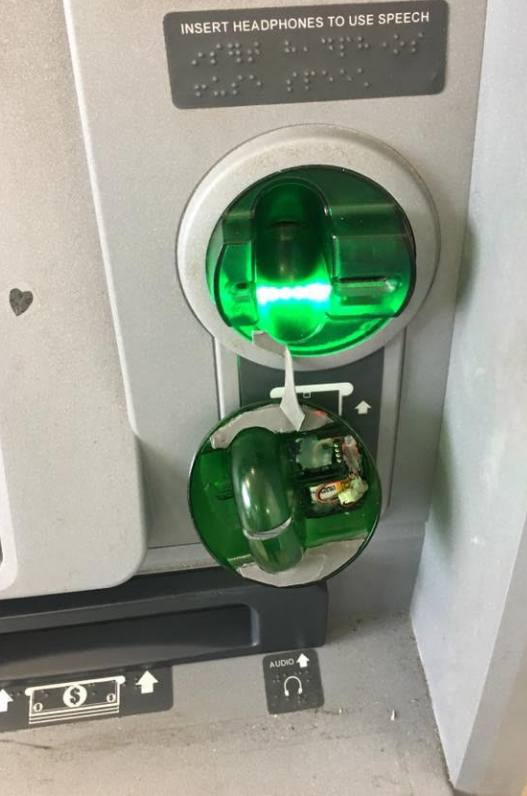
A skimmer overlay that came off an ATM at a 7-Eleven convenience store in Texas after a curious customer tugged on the card slot.
Many people believe that skimmers are mainly a problem in the United States, where most ATMs still do not require more secure chip-based cards that are far more expensive and difficult for thieves to clone. However, it’s precisely because most U.S. ATMs lack this security requirement that skimming remains so prevalent in Europe.
Mainly for reasons of backward compatibility to accommodate American tourists, many European ATMs allow non-chip-based cards to be inserted into the cash machine. What’s more, many chip-based cards issued by American and European banks alike still have cardholder data encoded on a magnetic stripe in addition to the chip.
When thieves skim ATMs in Europe, they generally sell the stolen card and PIN data to fraudsters on the other side of the pond. Those fraudsters in turn will encode the card data onto counterfeit cards and withdraw cash at ATMs here in the United States.
Interestingly, even after most U.S. banks put in place chip-capable ATMs, the magnetic stripe will still be needed because it’s an integral part of the way ATMs work: Most ATMs in use today require a magnetic stripe for the card to be accepted into the machine. The main reason for this is to ensure that customers are putting the card into the slot correctly, as embossed letters and numbers running across odd spots in the card reader can take their toll on the machines over time.
Below is part of a skimming device that a reader recently pulled off of a compromised ATM in Dusseldorf, Germany. This component actually cracked off of the hard plastic fake anti-skimming bezel that was placed by a fraudster over top of the card acceptance device of an NCR cash machine there.
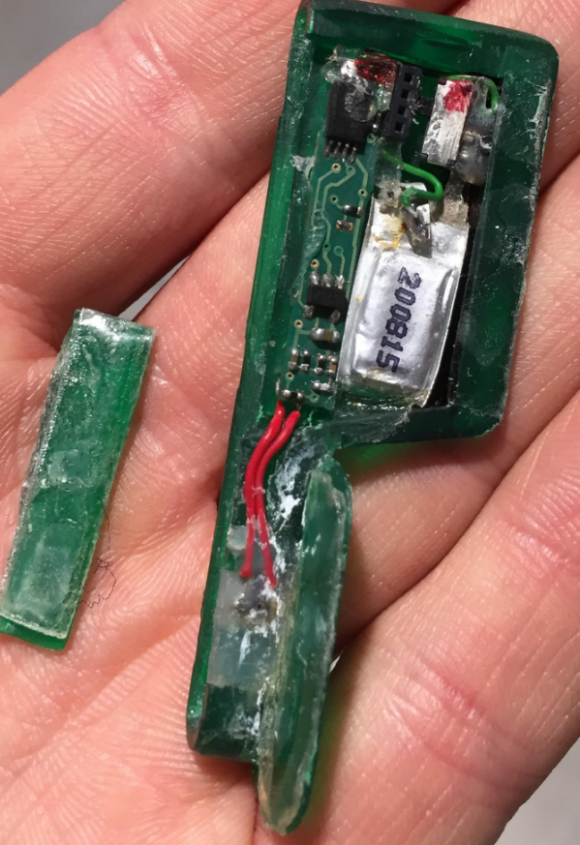
Here’s the plastic overlay that the piece pictured in the reader’s hand above broke away from:

It’s fine to tug on parts of an ATM before using it (heck, I’ve been known to do this even for machines I have no intention of using), but just know that doing so doesn’t guarantee that you will detect a cleverly hidden skimmer.
As I’ve noted in countless skimmer stories here, the simplest way to protect yourself from ATM skimming is to cover your hand when entering your PIN. That’s because most skimmers rely on hidden cameras to steal the victim’s PIN. As easy as this is, you’d be amazed at how many people fail to take this basic precaution.
Yes, there is still a chance that thieves could use a PIN-pad overlay device to capture your PIN, but in my experience these are far less common than hidden cameras (and quite a bit more costly for thieves who aren’t making their own skimmers).
Also, if you visit an ATM that looks strange, tampered with, or out of place, try to find another cash machine. Use only machines in public, well-lit areas, and avoid ATMs in secluded spots. Finally, don’t neglect your own physical security while at the cash machine: As common as these skimmers are, you’re probably more likely to get mugged withdrawing cash from an ATM than you are to find a skimmer attached to it.
Did you enjoy this post? Are you fascinated by skimming devices? Check out my series, All About Skimmers.




Why is that stupid plastic in front of the reader there in the first place?
It’s looks safer to me if there is only a slot in rhe metal; harder to hide anything in front of that.
Agree with Lief.
Anti-skimming devices might have a role to play, but their scattered and inconsistent deployment only makes things harder for consumers. There’s no “known good configuration” for me, even when using the same bank’s ATMs.
Meanwhile, I risk breaking legitimate machines by pulling & prodding them!
More excellent work from Mr Krebbs, and I give much thanks for it, but defenders are on the back foot here like everywhere else, and it’s clear to me that this attempted defence too easily becomes an extension of attack surface both physically and in social engineering terms.
Video of this in Vienna. You can ignore the plug for the guy’s company, but still a good example of this happening in the wild: https://www.youtube.com/watch?v=ll4f0Wim4pM
Check your ATMs, it take a second.
The best way to protect your card is to not use it. In many european countries there are 3 way handshake token based atm withdrawals where you first generate a token from your smartfonie banking app, and after atm validates it with bank you confirm with PIN on your banking app again. ATM can have 10 skimmer devices on it and I can still use it securely.
This is one reason why I use the NFC as a mean to withdraw cash if needed. The only problem is that few banks are deploying it. Additionally banks deploying bank app with generated code+PIN that is good for 30 or less.
FWIW: Drive-up ATMs at the bank do not allow one to cover the numeric pad while entering your PIN. Gotta go inside…bummer.
I stopped using ATMs and now go to one of my credit union’s service centers to withdraw cash. This after someone stole my ATM card number and apparently fabricated a new card but didn’t have the PIN (no camera at the point of theft, or else my attempt to cover my PIN entry actually worked). I will only use an ATM in an emergency now.
I’ve personally found and removed 2 of the smaller versions like the bottom one here in Berlin. The ATMs are very common around here.
They tend to use some kind of hard clear glue to attach them, which leaves behind a bit after the skimmer has been removed.
I’d say 80% of the ATMs of this type I’ve seen in Berlin have evidence that a skimmer has been installed. The least-tampered with ones seem to be the ones out front of Spätis, especially if they’ve got a small beer table out front. Scammers probably figure the people sitting out front are likely to spot their skimmer and fuck with it.
You’re a good man Mr. Krebs ! Very Informative – Thanks for sharing.
I personally don’t care if there is a skimmer. All fraud is the bank’s responsibility and will not cost me a dime as long as I monitor my account. I’m not ever doing their job for them. They have enough money.
I’m not surprised people don’t protect their PIN with their hand. It took me a while to understand why you have to do it – the usual instructions just state it’s “to protect against people looking over your shoulder”! If there’s nobody within a reasonable distance, obviously you wouldn’t feel threatened based on these instructions.
I think people develop instruction allergy (I do, in any case) – if nobody tells them why they have to do it, they don’t do it, to protect against the flood of instructions we constantly receive from experts who turn out to be wrong after a while. If security measures aren’t explained well, they aren’t going to be followed appropriately.